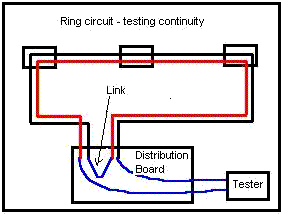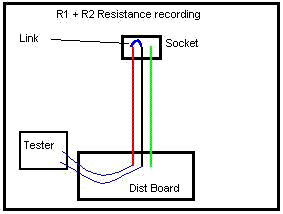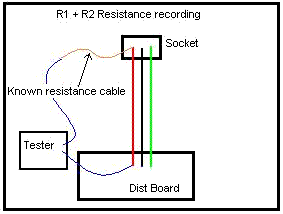Electrical Testing
Electrical installation testing should only be carried out by qualified professional electricians, with the relevant equipment - the following tests cannot otherwise be carried out.
The test procedures outlined in this page are based on a new domestic dwelling with all electrical equipment in place.
The test procedures are generally split up into two bands, 'Dead testing' and 'Live testing'.
Dead testing is, as it sounds, performed on the circuits when they are de-energized, and form the initial testing of the circuits. These tests will outline the insulation resistance of the new circuits, and the continuity of the ring circuits.
IMPORTANT: ON EXISTING INSTALLATIONS, ENSURE ALL EQUIPMENT IS UNPLUGGED FROM THE CIRCUITS, these tests produce high voltages and will damage some equipment. Any apparatus plugged into a circuit that is being tested will also cause poor readings.
Tip: ensure all neon's are removed or isolated before commencing testing, as these will make test results appear low during insulation resistance testing.
Live testing is then performed on the circuits once the results of the dead tests have been recorded as satisfactory, and once the installation has been put back together following the dead testing.
The table below indicates the order that tests should be carried out.
| Test order | Type of test | Reading Measured in |
|
(Dead test) 1 |
Ring Circuit loop Impedance | Ohms using 'mega' (set on ohm) |
| (Dead test) 2 | Circuit loop Impedance | Ohms using 'mega' (set on ohm) |
| (Dead test) 3 | Insulation Resistance | Meg Ohms using 'mega' (set on 500v) |
| (Live test) 4 | Polarity | Martindale or Earth loop impedance meter |
| (Live test) 5 | Earth Loop Impedance | Earth loop impedance tester |
| (Live test) 6 | Prospective Short Circuit Current (PSC) | PSC Tester (may be included in Earth loop tester) |
| (Live test) 7 | RCD testing (if applicable) | RCD tester |
1. Ring Circuit Loop Test (dead test)
Reason for the test: Ring Circuit loop testing ensures that any ring circuits wired in the installation are actually a ring circuit and not forming a radial, or 'figure of eight loops'.
Results recorded as R1, Rn, R2. (one result for each core of a 3 core cable in a ring circuit)
1. First open the ends of the ring circuit at the consumer unit, (for all conductors).
2. Connect the live of one end of the ring to the neutral of the other end of the ring and test between the live and neutral remaining. This tests the cables in the ring in a double loop format, to ensure the conductors form a ring without figure of eights. Perform this test using a mega in Meg Ohms.

3. On completion of this test, remove the link and proceed to test live to live, neutral to neutral, earth to earth. Record these results in Ohms.
2. Circuit Loop Test (dead test)
Reason for the test: Circuit loop testing ensures that any circuit wired in the installation are actually containing cables that conduct one end of the cable to the other, without a huge resistance in its path. Result recorded as R1+ R2
1. First open the ends of the circuit at the consumer unit, (for all conductors).
2. (To record R1+R2) Connect the live end of the cable to the tester, then connect the neutral to the tester. Ensure that at the end of the circuit (ie, at the furthest socket) that you short out the live and neutral conductors. Perform this test using a 'mega' in Ohms. This result is R1+R2.
2a. (To record R2) To provide an accurate R2 result, instead of connecting the neutral conductor to the tester, connect the tester to a long piece of cable with a known resistance, then connect the other end of this cable to the live of the furthest socket in this circuit. The reading you achieve must then have the resistance of the 'known resistance cable' deducted.
For example result = 4ohms, Known cable resistance is 1.2 ohms, therefore 4ohms - 1.2 ohms = 2.8ohms (the actual result of R2)


3. Insulation Resistance Test (dead test)
Reason for the test: To ensure the insulation of the cable has not been damaged, and has no faults present. Results recorded in Meg Ohms
Connect the test probes to the live and neutral of the cable that requires testing, then test!! Repeat the procedure between the live and earth, and the neutral and earth.
Notes: Neon's will cause false readings, as will emergency or discharge lighting, so ensure these are all disconnected prior to commencing tests.
4. Polarity Testing (live test)
Reason for this test: to ensure apparatus connected to the circuit is connected correctly, and does not become damaged. Results shown by indicators on tester.
Plug in tester, and ensure the polarity is correct according to the charts on the test instrument. (Varies from tester to tester)
5. Earth Loop Impedance Test (live test)
Reason for test: To ensure the resistance of the earth cable is not so high as to prevent it from working correctly in the event of a fault.
Please note the chart below, which is intended as a guide for the Maximum Earth Loop Impedance permitted by the current regulations.
To perform the test plug in the instrument, set the range to the lowest setting first and press test, then record the result (if over range turn the testers range up to the next setting and repeat the test).
| MCB Rating | Type 1 MCB | Type 2 MCB | Type B MCB | Type C & 3 MCB | Type D MCB |
| 6 | 8.0 | 4.56 | 6.4 | 3.2 | 1.6 |
| 10 | 4.8 | 2.74 | 3.84 | 1.92 | 0.96 |
| 16 | 3.0 | 1.7 | 2.4 | 1.2 | 0.6 |
| 20 | 2.9 | 1.36 | 1.92 | 0.96 | 0.48 |
| 32 | 1.5 | 0.85 | 1.2 | 0.6 | 0.3 |
| 40 | 1.2 | 0.68 | 0.96 | 0.48 | 0.24 |
| 63 | 0.76 | 0.43 | 0.6 | 0.3 | 0.15 |
BREAKERS DIFFERING FROM THOSE SHOWN- ie.5 & 30amp (Crabtree C50) ARE NOT THE SAME READINGS AS INDICATED.
Allows for both 0.4 & 5.0 second disconnection times. Based on 230volt system.
These values are Zs values found in tables 41B1, 41B2 & 41D of the regs.
6. Prospective Short Circuit Test (live test)
Reason for the test: To ensure that in the event of a short circuit, the cable tested can carry enough fault current, to trip the MCB or blow a fuse, as quickly as possible (and within the stated regulation guideline times of 0.4 seconds for socket outlets (portable equipment) and 5 seconds for fixed equipment).
Plug in the test equipment and press test, the higher the result the better.
Result should be recorded in hunderds of amps.
7. Residual Current Device Test (live test)
Reason for the test: To ensure that the RCDs installed will trip fast enough in the event of a fault, to prevent electrocution.
Plug in test equipment (set at the rating of the RCD), and set the test at 0.5 of the RCD's rated tripping current - the RCD must not trip out.
Repeat the test at the rated tripping current of the RCD, the device should trip out in around 0.3 of a second.
Repeat the test again, setting the test at 5 times the rating of the RCD, the RCD must trip faster than the last result (even though only slightly).
For full details on tripping times, refer to the 16th Edition of the IEE wiring regulations.
Hopefully these notes will form part of a useful reference, if you have any comments or suggestions on this page, please e-mail us here Direct!!